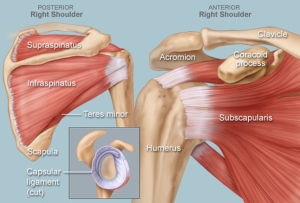Tagged: Separation
Shoulder Dislocation vs. Separation
Dr. Mark Wichman, an orthopedic surgeon with Aurora Healthcare, has practiced in his specialty for more than 25 years. Particularly experienced in the treatment of shoulder instability, Dr. Mark Wichman stands out as author of a chapter on interval and posterior plication in the textbook Management of the Unstable Shoulder.
Typically, patients with shoulder instability have either a dislocation of the glenohumeral (GH) joint or a separation of the acromioclavicular (AC) joint. Separation of the AC joint indicates damage to the ligaments connecting the collarbone to the upper scapula. Because these ligaments play a crucial role in suspension of the arm, the humeral bone can then slip out of place and push toward the tip of the shoulder.
A dislocation of the GH joint, by contrast, occurs when the humerus slips out of the cup formed by the glenoid structure of the scapula. It indicates a weakness in the connection between these neighboring structures, most often exacerbated by a traumatic injury. Dislocation typically manifests as an anterior shift of the humeral head, though some patients experience a posterior shift or a universal looseness throughout the joint.
Either condition may potentially be treatable through surgery, though any decisions regarding intervention will depend on the patient’s condition. Areas of consideration include the patient’s age and activity level, as well as the severity and frequency of separation or dislocation.
Dr. Wichman has been team physician for the Milwaukee Admiral’s hockey team for 13 years. Shoulder dislocations and separations are extremely common among professional hockey players. Arthroscopic techniques for repairing dislocated shoulders and separated shoulders have come a long way allowing these techniques to help professional athlete and weekend athletes alike.
